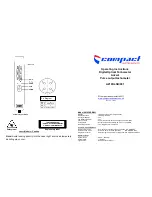
5 Determining location
SMARTS II
29
5
Determining location
This chapter include points to consider when choosing the SMARTS II
monitoring location.
5.2 Factors determining area coverage
5.1 Overview
The factors that determine when a SMARTS II monitor will activate its
alarms include:
Alarm threshold setting of the monitor
The field strength at the monitor in terms of percent of the respective
human safety standard.
The alarm threshold is set at the factory at 50% of Standard. Three more
sensitive settings are available: 35%, 25%, and 10% of Standard.
The actual field strength required for the monitor to activate its alarms
depends not only on the alarm threshold setting but the field strength of
each frequency component. The sensitivity of SMARTS II area monitors
varies with the specific model. All models have shaped frequency
response. For example, one model follows the ICNIRP 1998
occupational limits. The ICNIRP 1998 occupational limits are 1 mW/cm2
from 10 MHz to 400 MHz and 5 mW/cm2 above 2 GHz. If the SMARTS
II was set to the least sensitive setting of 50% of Standard, then the
threshold (excluding tolerances) would be 0.5 mW/cm2 in the VHF
region and 2.5 mW/cm2 in the microwave region. The "weighting" of the
frequency response of the sensors automatically compensates for
multiple signal environments.
Area coverage is a far more complicated subject. There are several
factors that should be considered in determining the best location for the
monitor and the area that can be considered "protected".
Содержание L3HARRIS SMARTS II
Страница 1: ...SMARTS II Ultra Wideband RF Radiation Area Monitor Operating Manual...
Страница 36: ...36 SMARTS II 7 3 Outline drawing...
Страница 37: ...7 Specifications SMARTS II 37 7 4 Declaration of conformity...
Страница 38: ...38 SMARTS II 7 5 Declaration of origin Country of Origin Germany...












































